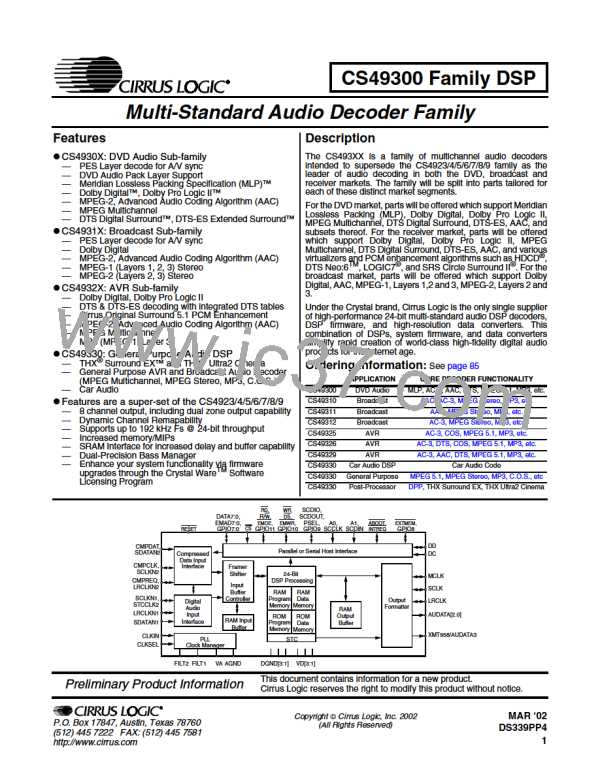CS49300 Family DSP
byte, and the host should poll the Host Control
Register again. If HINBSY is low, then the host
byte response from the DSP. The host must read the
response byte and act accordingly. The boot
may write a control byte into the Host Message procedure is discussed in Section 8.1, “Host Boot”
Register.
on page 52.
3) The host knows that the DSP is ready for a new
During regular operation (at run-time), the
control byte at this point and should write the responses from the CS493XX will always be 6
control byte to the Host Message Register
(A[1:0] = 00b).
bytes in length.
The example shown in this section can be used for
any control read situation. The generic function
‘Read_Byte_*()’ is used in the following example
4) If the host would like to write any more control
bytes to the CS493XX, the host should once
again poll the Host Control Register (return to as
a
generalized
reference
to
either
step 1).
Read_Byte_MOT()
or Read_Byte_INT().
Figure 29 shows a typical read sequence. The
protocol presented in Figure 29 will now be
described in detail.
6.2.3.2.Control Read in a Parallel Host Mode
When reading control data from the CS493XX, the
same protocol is used whether the host is reading a
single byte or a 6 byte message.
1) Optionally, INTREQ going low may be used as
an interrupt to the host to indicate that the
CS493XX has an outgoing message. Even with
the use of INTREQ, HOUTRDY must be
checked to insure that bytes are ready for the
host during the read process. Please note that
INTREQ does not go low to indicate an
outgoing message during boot.
During the boot procedure, a handshaking protocol
is used by the CS493XX. This handshake consists
of a 3 byte write to the CS493XX followed by a 1
READ_BYTE_*(HOST CONTROL REGISTER)
2) The host reads the Host Control Register
(A[1:0] = 01b) in order to determine the state of
the communication interface. Please note that
‘Read_Byte_*()’ is a generalized reference to
YES
HINSBY==1
either
Read_Byte_MOT()
or
NO
Read_Byte_INT().
3) In order to determine whether the CS493XX
has an outgoing control byte that is valid, the
host must check the HOUTRDY bit of the Host
Control Register (bit 1). If HOUTRDY is high,
then the Host Message Register contains a valid
message byte for the host. If HOUTRDY is
low, then the DSP has not placed a new control
byte in the Host Message Register, and the host
should poll the Host Control Register again.
WRITE_BYTE_*(HOST MESSAGE REGISTER)
YES
MORE BYTES
TO WRITE?
NO
FINISHED
4) The host knows that the DSP is ready to
provide a new response byte at this point. The
Figure 28. Typical Parallel Host Mode Control
Write Sequence Flow Diagram
DS339PP4
47

 CIRRUS [ CIRRUS LOGIC ]
CIRRUS [ CIRRUS LOGIC ]